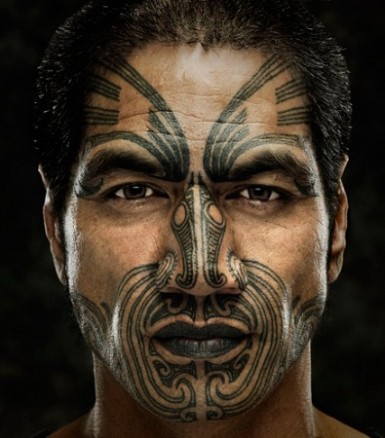My junior year of high school, I was able to travel to New Zealand (NZ) to visit my brother who was living there at the time. While I was there I fell in love with NZ and found the Maori culture to be very interesting. And while trying to decide what to post about this week I decided to look into the Maori culture.
What I decided to focus on was the Maori traditional practice of ta moko.
This excerpt from National Geographic’s interview with a Maori Chief explains where they believe moko originated.
The moko is our signature…It is what our ancestors signed their documents with. They used their facial moko when they first traded with the Europeans—the British. Historically, we say that moko comes from the underworld.
The gods associated with the tattooing gave it to the people to bring up to the surface. It is a beautiful metaphor for the revival, because we say that it was underground when it was abolished and there was persecution. We have brought it back up to the surface again like they did in the ancient times…It is not a static art form. It is a breathing, living, growing art form.
Reading that excerpt made me wonder what moko is to the Maori. The selection below from New Zealand’s official website explains what it is.
“A moko – traditional Maori tattooing, often on the face – is a taonga (treasure) to Maori for which the purpose and applications are sacred. Every moko contains ancestral / tribal messages specific to the wearer. These messages tell the story of the wearer’s family and tribal affiliations, and their place in these social structures. A moko’s message would also contain the wearer’s ‘value’ by way of their genealogy, and their knowledge and standing in their social level. Kirituhi means skin art and describes more general tattooing.”
Moko can be all over the body but is often on their faces. Face tattoos in Western culture are not very common and as a result I always thought face tattoos were very extreme and reckless. The NZ website also had a Q & A section that helped me understand why people get facial moko.
Why do people get facial moko?
A moko on the face is the ultimate statement of one’s identity as a Māori. The head is believed to be the most sacred part of the body. To wear the moko on the face is to bear an undeniable declaration of who you are.
Is it only men that get moko?
Women wear moko on the face too. A woman’s moko is worn on the chin, as well as occasionally appearing on the forehead, upper lip, nostrils, and throat.
Why does facial moko look so scary?
Sometimes facial moko is unfairly seen as intimidating, regardless of the wearer’s intentions, but this can depend on the countenance of the wearer. The lines of a moko accentuate the lines of the face so emphasise the expressions.
“To wear the moko on the face is to bear an undeniable declaration of who you are.” What a powerful sentence! Getting a face tattoo isn’t like some westerners’ face tattoos that are a result of a drunken night. Maori’s moko is a declaration of who they are and a symbol of their culture and is seen as living art.
However it does look scary to some people as the Q & A addresses above. To me it makes them look like warriors from the past so I can understand why some would be threatened by their appearance. I think it makes them look powerful, even if that is not the intention.
The link below is to a video depicting a man undergoing the process to get his moko. It’s blurry so those who are squeamish should be fine-I was! It just shows you that this painful, lengthy transformation is truly art. The Maori are proud to wear their moko and proud of others who get it. It is a representation of the Maori’s continuous embracement of the their culture, taking the old and bringing it up along side the new.
https://www.youtube.com/watch?v=rA62NxfwBv4
All of this made me wonder why I find western facial tattoos so reckless and see facial moko as art. I am seeing the beauty of the Maori, putting them in a separate category, while embracing the beauty standard of western culture seeing facial tattoos as ugly and not the norm. Breaking the mold that seems to have a grip on my judgment has been difficult for me. I can appreciate another culture but have a double standard for my own. This blog has really opened my eyes to how programmed I am into western ideals and how difficult appreciating different beauty practices really is.
“Everyone pretends to be ‘free thinkers’, but few individuals pass the line into expressive territories that may be detrimental to their own social well-being.”
~Criss Jami.
Works Cited
“Maori Culture.” Ta Moko. Newzealand.com, n.d. Web. 02 Apr. 2014. <http://www.newzealand.com/travel/media/features/maori-culture/maori_ta-moko-significance_feature.cfm>.
Mitchell, Ryan. “Maori Chief on Facial Tattoos and Tribal Pride.” National Geographic. National Geographic Society, 28 Oct. 2010. Web. 04 Apr. 2014. <http://news.nationalgeographic.com/news/2003/10/1014_031014_georgenuku_2.html>.
Nunes, Becky. Mau Moko: Victor Taurewa Biddle. 2008. Mau Moko- The World of Maori Tattoo Book Project. Gow Langsford Gallery. By Gow Langsford Gallery. Web. 04 Apr. 2014. <http://www.gowlangsfordgallery.co.nz/exhibitions/pastexhibitions/2012/windowgallery/beckynunes.asp?artwork=3161>.
Serenagiovanna. “Moko – Art of Nature. A Small Part of the Face Value Project.” YouTube. YouTube, 07 Aug. 2007. Web. 04 Apr. 2014. <https://www.youtube.com/watch?v=rA62NxfwBv4>.
